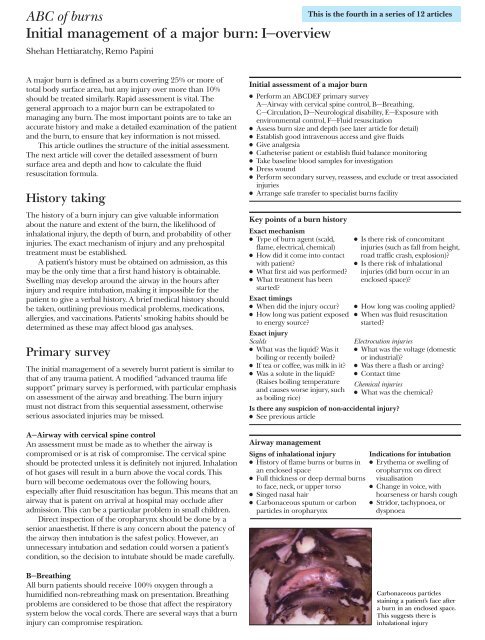ABC of Burns
You also want an ePaper? Increase the reach of your titles
YUMPU automatically turns print PDFs into web optimized ePapers that Google loves.
<strong>ABC</strong> <strong>of</strong> burns<br />
Initial management <strong>of</strong> a major burn: I—overview<br />
Shehan Hettiaratchy, Remo Papini<br />
This is the fourth in a series <strong>of</strong> 12 articles<br />
A major burn is defined as a burn covering 25% or more <strong>of</strong><br />
total body surface area, but any injury over more than 10%<br />
should be treated similarly. Rapid assessment is vital. The<br />
general approach to a major burn can be extrapolated to<br />
managing any burn. The most important points are to take an<br />
accurate history and make a detailed examination <strong>of</strong> the patient<br />
and the burn, to ensure that key information is not missed.<br />
This article outlines the structure <strong>of</strong> the initial assessment.<br />
The next article will cover the detailed assessment <strong>of</strong> burn<br />
surface area and depth and how to calculate the fluid<br />
resuscitation formula.<br />
History taking<br />
The history <strong>of</strong> a burn injury can give valuable information<br />
about the nature and extent <strong>of</strong> the burn, the likelihood <strong>of</strong><br />
inhalational injury, the depth <strong>of</strong> burn, and probability <strong>of</strong> other<br />
injuries. The exact mechanism <strong>of</strong> injury and any prehospital<br />
treatment must be established.<br />
A patient’s history must be obtained on admission, as this<br />
may be the only time that a first hand history is obtainable.<br />
Swelling may develop around the airway in the hours after<br />
injury and require intubation, making it impossible for the<br />
patient to give a verbal history. A brief medical history should<br />
be taken, outlining previous medical problems, medications,<br />
allergies, and vaccinations. Patients’ smoking habits should be<br />
determined as these may affect blood gas analyses.<br />
Primary survey<br />
The initial management <strong>of</strong> a severely burnt patient is similar to<br />
that <strong>of</strong> any trauma patient. A modified “advanced trauma life<br />
support” primary survey is performed, with particular emphasis<br />
on assessment <strong>of</strong> the airway and breathing. The burn injury<br />
must not distract from this sequential assessment, otherwise<br />
serious associated injuries may be missed.<br />
A—Airway with cervical spine control<br />
An assessment must be made as to whether the airway is<br />
compromised or is at risk <strong>of</strong> compromise. The cervical spine<br />
should be protected unless it is definitely not injured. Inhalation<br />
<strong>of</strong> hot gases will result in a burn above the vocal cords. This<br />
burn will become oedematous over the following hours,<br />
especially after fluid resuscitation has begun. This means that an<br />
airway that is patent on arrival at hospital may occlude after<br />
admission. This can be a particular problem in small children.<br />
Direct inspection <strong>of</strong> the oropharynx should be done by a<br />
senior anaesthetist. If there is any concern about the patency <strong>of</strong><br />
the airway then intubation is the safest policy. However, an<br />
unnecessary intubation and sedation could worsen a patient’s<br />
condition, so the decision to intubate should be made carefully.<br />
B—Breathing<br />
All burn patients should receive 100% oxygen through a<br />
humidified non-rebreathing mask on presentation. Breathing<br />
problems are considered to be those that affect the respiratory<br />
system below the vocal cords. There are several ways that a burn<br />
injury can compromise respiration.<br />
Initial assessment <strong>of</strong> a major burn<br />
x Perform an <strong>ABC</strong>DEF primary survey<br />
A—Airway with cervical spine control, B—Breathing,<br />
C—Circulation, D—Neurological disability, E—Exposure with<br />
environmental control, F—Fluid resuscitation<br />
x Assess burn size and depth (see later article for detail)<br />
x Establish good intravenous access and give fluids<br />
x Give analgesia<br />
x Catheterise patient or establish fluid balance monitoring<br />
x Take baseline blood samples for investigation<br />
x Dress wound<br />
x Perform secondary survey, reassess, and exclude or treat associated<br />
injuries<br />
x Arrange safe transfer to specialist burns facility<br />
Key points <strong>of</strong> a burn history<br />
Exact mechanism<br />
x Type <strong>of</strong> burn agent (scald,<br />
flame, electrical, chemical)<br />
x How did it come into contact<br />
with patient?<br />
x What first aid was performed?<br />
x What treatment has been<br />
started?<br />
Exact timings<br />
x When did the injury occur?<br />
x How long was patient exposed<br />
to energy source?<br />
Exact injury<br />
Scalds<br />
x What was the liquid? Was it<br />
boiling or recently boiled?<br />
x If tea or c<strong>of</strong>fee, was milk in it?<br />
x Was a solute in the liquid?<br />
(Raises boiling temperature<br />
and causes worse injury, such<br />
as boiling rice)<br />
x Is there risk <strong>of</strong> concomitant<br />
injuries (such as fall from height,<br />
road traffic crash, explosion)?<br />
x Is there risk <strong>of</strong> inhalational<br />
injuries (did burn occur in an<br />
enclosed space)?<br />
x How long was cooling applied?<br />
x When was fluid resuscitation<br />
started?<br />
Electrocution injuries<br />
x What was the voltage (domestic<br />
or industrial)?<br />
x Was there a flash or arcing?<br />
x Contact time<br />
Chemical injuries<br />
x What was the chemical?<br />
Is there any suspicion <strong>of</strong> non-accidental injury?<br />
x See previous article<br />
Airway management<br />
Signs <strong>of</strong> inhalational injury<br />
x History <strong>of</strong> flame burns or burns in<br />
an enclosed space<br />
x Full thickness or deep dermal burns<br />
to face, neck, or upper torso<br />
x Singed nasal hair<br />
x Carbonaceous sputum or carbon<br />
particles in oropharynx<br />
Indications for intubation<br />
x Erythema or swelling <strong>of</strong><br />
oropharynx on direct<br />
visualisation<br />
x Change in voice, with<br />
hoarseness or harsh cough<br />
x Stridor, tachypnoea, or<br />
dyspnoea<br />
Carbonaceous particles<br />
staining a patient’s face after<br />
a burn in an enclosed space.<br />
This suggests there is<br />
inhalational injury



